WORDPRESS
9 Best ActiveCampaign Alternatives in 2023 (Compared)

Are you looking for the best ActiveCampaign alternatives for your website?
ActiveCampaign is a popular marketing automation tool that offers a suite of features, including email marketing, forms, sales automations, and more. However, you may be looking for an alternative to better fit your needs.
In this article, we will share a list of some of the best ActiveCampaign alternatives that you can use on your WordPress site.
Why Use an ActiveCampaign Alternative?
ActiveCampaign is a popular automation and marketing platform that allows small businesses to connect with their customers in multiple ways.
By using ActiveCampaign on your WordPress website, you can launch an email marketing campaign, do customer relationship management (CRM) and eCommerce marketing, create forms and landing pages, and much more.
However, ActiveCampaign may not be the best choice for you because it’s a bit difficult to navigate for beginners and can be expensive for small businesses. It might also not have all the features that you will need for automation marketing.
Additionally, some users have also complained that ActiveCampaign does not offer good customer support.
That being said, here is our list of some of the best ActiveCampaign alternatives that you can use on your WordPress site.
1. Constant Contact
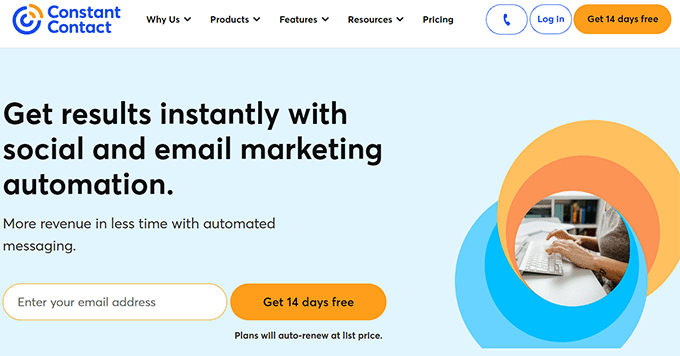
Constant Contact is the best email marketing service that also offers a suite of other tools, including marketing automation, SMS marketing, event marketing, CRMs, landing pages, and so much more.
It is the best ActiveCampaign alternative because it allows you to easily automate your emails, SMS, and social media platforms using its drag-and-drop functionality.
Constant Contact also offers other features like A/B testing, mobile apps, event marketing, forms, and list-building tools.
It also has its own built-in CRM, allows you to segment your audience, and can integrate with over 5000 apps, including Zapier, WooCommerce, and Salesforce.
Other than being an automation tool, Constant Contact is also the best WordPress newsletter tool because it connects with WPForms to let you easily build newsletter subscription forms.

Pros
- Constant Contact offers email campaign templates.
- It can easily connect with your WordPress site.
- It is more affordable than ActiveCampaign.
- The platform offers detailed analytics and reports.
- Constant Contact also makes the process of switching from different platforms super easy.
Cons
- It does not offer a free version.
Why we recommend using Constant Contact: Constant Contact is the overall best ActiveCampaign alternative because it has all the features required for marketing automation. It offers SMS marketing, email marketing, social media marketing, and many other tools, making it one of the best automation tools for small businesses.
2. HubSpot
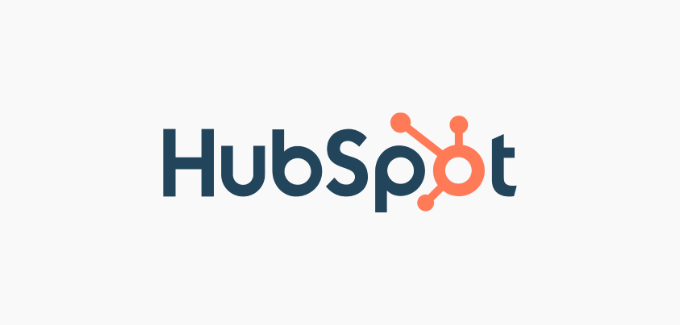
HubSpot is an all-in-one marketing software that offers CRM, sales, marketing, operations, and service tools for your website.
It is the perfect ActiveCampaign alternative if you are looking for sales automation. This is because its CRM tool allows you to organize your customer data and view your entire sales funnel in a visual dashboard.
With HubSpot, you can send automated emails, schedule meetings with your leads from the CRM, track leads as they move through the sales process, score leads based on engagement, and even monitor your sales performance.
Pros
- Other than sales, HubSpot offers email and SMS marketing automation.
- It comes with a landing page builder, form builder, SEO recommendations, ad management, and a chatbot builder.
- Its workflow feature allows you to automate your marketing tasks, and it can integrate with over 1300 apps.
- HubSpot has a free plugin.
Cons
- HubSpot’s paid plan can be expensive for startups or small business websites.
- It does not have the best customer support.
Why we recommend using HubSpot: HubSpot is the best automation marketing tool if you want to focus on sales automation marketing. This is because HubSpot is the best CRM software for business websites. Plus, HubSpot also offers email and SMS marketing automation.
3. Brevo

Brevo (formerly Sendinblue) is a popular SMS and email marketing tool that also comes with automation features.
It allows you to automate marketing tasks like sending emails, SMS messages, and WhatsApp campaigns.
Brevo also lets you build custom workflows, offers a CRM, comes with a drag-and-drop builder, and even lets you create personalized automated SMS and emails.
Pros
- Brevo allows you to segment your audience based on different demographics for automated emails and SMS messages.
- It lets you create landing pages and comes with A/B testing, a transactional email service, a sales platform, and multichannel marketing features.
- It is more affordable and easy to use than ActiveCampaign.
Cons
- Brevo’s CRM has basic features.
- Brevo has limited automation features compared to other tools on this list.
Why we recommend using Brevo: You should opt for Brevo if you are looking for a marketing automation tool that’s beginner-friendly and comes with basic marketing automation features. Brevo is also a good choice if you run a small WordPress blog because it’s easy to use and offers a free plan.
4. Omnisend

Omnisend is a well-known marketing automation platform for eCommerce websites.
It is the best ActiveCampaign alternative if you have an online store and are looking to automate emails, SMS, push notifications, WhatsApp campaigns, and more.
Omnisend also lets you segment your audience based on different demographics to send targeted automated messages to users.
Pros
- With Omnisend, you can personalize your messages with the recipient’s name, location, and other data.
- It provides detailed reports on your marketing performance.
- It allows you to create custom workflows and comes with email templates and a visual email builder.
- You can use pre-built eCommerce workflows, an automation editor, and an automation split feature.
- Its other eCommerce features include customer lifecycle data, on-site behavior, message engagement, and more.
Cons
- Omnisend can be expensive for small businesses.
- The tool can be difficult to navigate for beginners.
Why we recommend using Omnisend: Omnisend is a great ActiveCampaign alternative if you have an online store and need omnichannel software to manage your automated emails, SMS, Facebook Messenger messages, WhatsApp messages, and push notifications.
5. AWeber
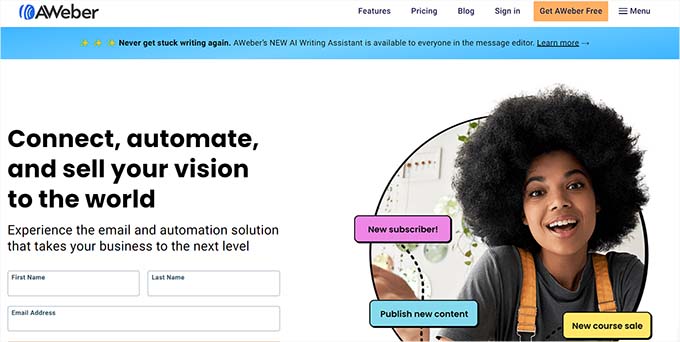
AWeber is a beginner-friendly ActiveCampaign alternative that lets you send automated emails and newsletters.
It’s a popular email marketing service that comes with email templates, audience segmentation, A/B testing, analytics, and more.
Plus, it can also integrate with popular eCommerce platforms, including WooCoomerce, Shopify, and Easy Digital Downloads.
Pros
- It’s a great autoresponder tool that also lets you create landing pages.
- You can easily connect it to your WordPress site using the free AWeber plugin. For more details, see our tutorial on how to connect AWeber to WordPress.
- It has a free version.
- AWeber comes with support materials, including master class sessions and live webinars.
- It has great customer support.
Cons
- AWeber’s premium plan can be expensive if you have a small business.
- The free version has AWeber branding, which can affect your brand.
- It has limited integrations and basic automation features.
Why we recommend using AWeber: Overall, AWeber is a good ActiveCampaign alternative for beginners because it has email marketing and basic automation features. Plus, it is more affordable than ActiveCampaign and has a free plan.
6. FunnelKit Automations
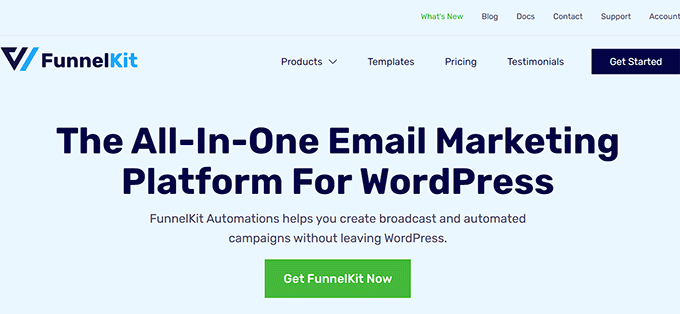
FunnelKit Automations is one of the best marketing automation services for WooCommerce stores. It allows you to launch email and SMS marketing campaigns, create automated workflows for your messages, and create drip sequences.
With FunnelKit Automations, you can also launch automated campaigns for abandoned carts, win back coupons, lead nurturing, purchase anniversaries, and more.
Pros
- The software allows you to create segmented and personalized messages for users.
- It enables you to create customized workflows and comes with a CRM, revenue tracking, A/B testing, and more.
- FunnelKit Automations has a drag-and-drop builder and a landing page builder.
Cons
- It’s a premium plugin that can be expensive for small businesses.
- It offers limited support.
Why we recommend using FunneKit Automations: If you have a WooCommerce store, then FunnelKit Automations is a great choice because its marketing automation features are specifically designed for WooCommerce.
7. MailerLite
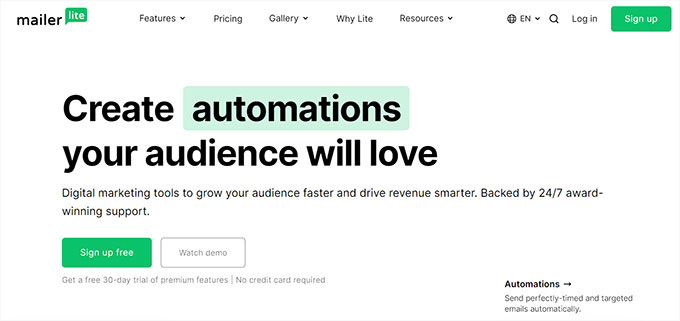
MailerLite is a popular email marketing service and ActiveCampaign alternative. It comes with a drag-and-drop builder, premade email templates, and even lets you create landing pages, newsletters, and opt-in forms.
With MailerLite, you can send automated emails when a subscriber joins a group or a customer purchases a product. You are even able to design multi-trigger email automations. This means that you can add 3 triggers for each automation and create multiple entry points for a single workflow.
Pros
- MailerLite comes with an analytics and reports feature.
- It is a super affordable alternative to ActiveCampaign.
- It can perform A/B testing, segment your audience, and let you create personalized emails to improve user engagement.
- MailerLite tracks your automation history.
Cons
- MailerLite offers basic triggers and actions for its automations, making it difficult to create complex workflows.
- It doesn’t offer any templates in the free plan.
Why we recommend using MailerLite: We recommend opting for this tool if you are on a bootstrap budget because MailerLite is super affordable and has all the features you need to create simple workflows.
8. Drip

Drip is a powerful email marketing platform that allows you to create automated sequences of emails that are sent to your subscribers based on their actions. It can segment your contact list so that your messages reach the right people.
It’s also a good choice for beginner users due to its visual builder, integration with over 200 tools, and ease of use.
Pros
- Drip marketing reports provide you with detailed insights into your email marketing performance.
- It comes with a landing page builder, A/B testing tool, and ad management features.
- Drip provides online courses and detailed documentation for its use.
Cons
- It is a bit more expensive than ActiveCampaign.
- Drip is not the best option for startups and beginners.
- It doesn’t have a free plan.
Why we recommend using Drip: Overall, Drip is a great alternative to ActiveCampaign if you want to focus on email marketing automation. This is because Drip is a super powerful email marketing service that also lets you automate SMS. It is also a good choice if you have an online store.
9. ConvertKit
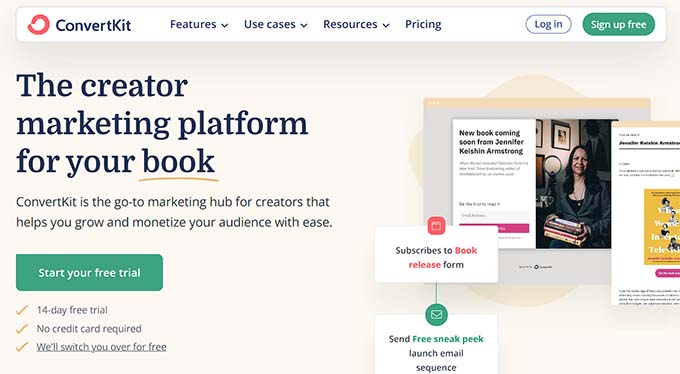
ConvertKit is another ActiveCampaign alternative that allows you to create complex automation workflows using a drag-and-drop builder.
It is a popular email marketing service that comes with premade templates and lets you create and send automated emails to users. Plus, the tool also lets you create landing pages, email opt-in forms, perform A/B testing, email blasts, and more.
Pros
- ConvertKit allows you to segment your audience based on different demographics.
- It’s flexible, and its visual builder is ideal for beginners.
- It offers reports and analytics for your emails.
Cons
- Even though ConvertKit has a free plan, you will need the premium plan to unlock its automation features.
- It does not offer SMS or social media marketing automations.
Why we recommend using ConvertKit: You should pick ConvertKit if you are looking for a tool that lets you manage your email campaign and automation workflows in one place. It’s also a great option if you are new to automated marketing because its visual builder is super easy to use.
What Is the Best ActiveCampaign Alternative?
In our expert opinion, Constant Contact is the best ActiveCampaign alternative since it is super easy to use, seamlessly connects with WordPress, and offers many automation features for all kinds of websites and online businesses.
However, if you have an online store, then Omnisend, Drip, AWeber, and FunnelKit Automations are also great choices due to their eCommerce-specific features.
Similarly, if you are looking for sales automation, then HubSpot is our pick because of its super powerful CRM and automation marketing features for emails, SMS, and social media platforms.
Finally, if you are on a budget, then MailerLite is a great choice because it is super affordable.
Frequently Asked Questions
Here are some of the questions that our readers usually ask us about ActiveCampaign and its alternatives.
What’s better than ActiveCampaign?
There are a number of tools that are better than ActiveCampaign in terms of ease of use, support, features, and pricing.
If you have a WooCommerce store, then you can switch from ActiveCampaign to FunnelKit Automations to unlock automation features designed specifically for WooCommerce.
Similarly, if you have a small business website, then Constant Contact is easier to use, is more affordable, and has many automated marketing features, making it a great alternative.
Tools like Drip, Brevo, AWeber, ConvertKit, and Omnisend are also better than ActiveCampaign when it comes to pricing, support, and features.
Is there a free version of ActiveCampaign?
ActiveCampaign does not offer a free version. If you are on a budget, then you can try HubSpot because it has a free plugin.
You can also use Brevo’s free plan or MailerLite as an affordable alternative to ActiveCampaign.
Best WordPress Guides for Automation
If you liked this article, then please subscribe to our YouTube Channel for WordPress video tutorials. You can also find us on Twitter and Facebook.


















